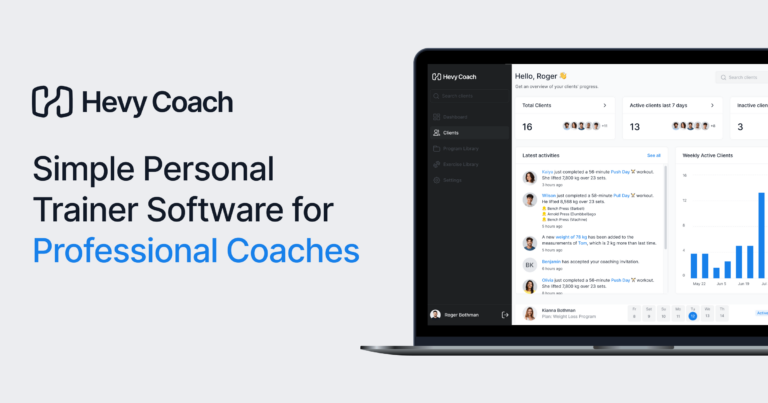Online fitness classes continue gaining popularity as they change how we think about working out. People can now opt for online sessions instead of going to the local gym to work with a qualified trainer.
Folks can log into their preferred platform, get in touch with a professional, and start working out in the comfort and privacy of their home.
With that in mind, let’s break down what people expect from online fitness classes and how you can provide a superior service to help your clients reach their goals.
What People Look for in Online Fitness Classes
The best online fitness classes offer the following to their clients:
- Flexibility and convenience
- Professional guidance
- Variety and personalized workouts
- Attention
- Privacy and comfort
- Reasonably priced services
- Flexibility when it comes to training equipment
- The ability to quickly join an online class without paying upfront
- On-demand fitness videos and workouts

Try Hevy Coach
Intuitive personal trainer software, with a world class experience for your clients.
30 day free trial, no credit card required
What are Online Fitness Classes?
Online fitness classes are a form of coaching done on the Internet, allowing trainees to work with professionals from all over the world and enjoy their workouts almost anywhere.
Live streaming is one popular option for online fitness classes. In that format, the instructor conducts a class, typically consisting of a brief introduction, a warm-up, the workout itself, and a cooldown period. The instructor can work with a single person or lead a group of trainees.
Online fitness classes can be held on Zoom, Google Meet, inside a fitness app, or on a special fitness platform.
Pre-recorded videos are also available for on-demand streaming. The advantage is that the client can use these resources whenever they want. The format also allows for more leisurely training, as clients can pause, rewind, or repeat portions of the videos as they see fit.
Coaches can send these pre-recorded videos to clients directly or upload them to a website.
Online fitness classes can cover classic bodyweight training, yoga, aerobic sessions, home gym training, and more.
An example of an online fitness platform is Daily Burn. Clients can pick from various workouts, including cardio, pilates, kettlebell workouts, mobility, yoga, and more. The service costs as little as $7.49 monthly and has a 30-day money-back guarantee.
8 Things People are Looking for in Online Fitness Classes
1. Flexibility and Convenience
While traditional gym training will forever be the favorite option for countless trainees, many people today seek flexibility and convenience to reach their fitness goals.
Commuting and rushing to be at the gym at a specific time can be stressful, and people often don’t have the time for that, especially if they work two jobs or are raising a family.
For these and other reasons, two big things people expect from online fitness classes are the flexibility to enjoy workouts at any time and the convenience of having sessions at home or outdoors.
An online fitness platform becomes even more desirable if the sign-up process is easy and doesn’t require an upfront payment.
2. Access to Professional Help
Working with a personal trainer one-on-one in a gym has many advantages. A solid coach can guide their clients by providing a tailored training plan, instructing on proper form, motivating clients to work hard, and pointing out mistakes they could be making.

The problem is that people can’t always hire a personal trainer. For example, they might be unable to pay for multiple sessions each month, or there might not be good coaches in the area.
Online coaching has grown in popularity because it gives people access to professionals worldwide. For example, if a person lives in a small town where there aren’t any good coaches, they can still work with a world-class trainer over the Internet.
Plus, with the sheer amount of free information available today, trainees often feel paralyzed and unsure of what to do to get fit, which means professional help is in demand. Those able to guide clients and help them reach their goals will create a good reputation in the fitness industry and earn a good living.
Speaking of guiding clients to success, check out Hevy Coach––our all-in-one platform for personal trainers and coaches. Write training programs, monitor your clients’ progress, communicate quickly, and much more, all from a single dashboard.
3. Variety and Personalization
People struggle to stay consistent with fitness because they lose interest in the process and end up dreading each upcoming workout. It all feels fresh, fun, and engaging initially, but the wave of motivation dissipates, leaving people to wonder, “Why am I even doing this?”
Cookie-cutter solutions, where everyone receives the same action plan, simply don’t work, as people crave personalized training plans. After all, a good fitness routine keeps people’s goals, preferences, lifestyle, nutrition, and other factors in mind.
For example, if someone wants to lose fat and only has a pair of dumbbells and a resistance band set at home, a good fitness class would guide them through effective workouts and steadily get them closer to that objective. The same goes for other goals: building muscle, gaining strength, etc.
Additionally, for trainees to stay motivated and look forward to upcoming workouts, there must be a fair amount of variety. Online classes need to change to some degree as time passes to keep clients engaged. Without the novelty factor, workouts become stale, people lose interest, and retention rates decline.
4. Attention and Privacy
High-quality trainers and fitness coaches understand that people need to feel heard, understood, and appreciated. It’s not enough to ask a few questions, put together a few virtual workouts, and call it a day.
Without attention, clients feel less invested and are more likely to walk away at the first sign of trouble.
Here are a few reasons why you should pay careful attention to your clients:
- Motivation and encouragement – a good online fitness class keeps clients engaged through ongoing support and positive reinforcement
- Monitoring effort – as a trainer, you must pay careful attention to your clients and make sure they are working hard enough to make progress toward their goals
- Ensuring safety – while online classes can’t replace in-person training, virtual communication can still allow coaches to keep a close eye on their clients and provide feedback in real-time to promote safety and point out potential errors
- Making adjustments – a good fitness coach knows that adjustments are part of the game and monitors each client to make tweaks at the right time and keep workouts fun, effective, and safe
Aside from attention, it’s essential to ensure privacy for your clients. Many people, especially beginners, feel self-conscious about their appearance and physical abilities and prefer not to compare themselves to others or compete.
In-person classes lack the element of privacy, which is why many beginners and people returning to fitness opt for online coaching.
As a trainer, your job is to provide a discrete workout environment where clients feel relaxed and able to open up.
5. Affordability
According to sources, one-on-one personal training sessions cost an average of $60 to $75 in the US and £30 to £60 in the UK.
As you can imagine, the cost of individual sessions can quickly add up, even if a person were to work with a more affordable trainer. For example, if someone hires a trainer who charges $50, three weekly sessions would cost $150. The cost shoots up to $600+ per month and a whopping $7200 yearly.
In contrast, online classes are far more affordable, with trainees typically paying for a monthly subscription. In some cases, as with FhittingRoom, trainees pay for each session, but the cost is generally far lower than in-person coaching.
Because of that, people interested in online fitness classes typically expect to pay far less than if they were to hire a trainer at their local gym.
The same goes for online courses. The market has grown exponentially over the last few years precisely because courses offer a simple and effective way for people to develop expertise in various fields without breaking the bank.
Related article: How to Price Personal Training Services: Here’s How Much You Should Charge

Try Hevy Coach
Intuitive personal trainer software, with a world class experience for your clients.
30 day free trial, no credit card required
6. Minimal Equipment Required
Trainees often struggle to have productive home workouts because they don’t have much (or any) exercise equipment. If anything, the average person only has a dumbbell or two, an exercise or yoga mat, and a couple of resistance bands.
You might be thinking, “Well, why not just train at a gym then? Memberships aren’t that expensive.”
That’s true, but there are other things to consider. For example, someone with a busy schedule might not be able to have three to four big, 60+ minute-long workouts each week. Instead, they might prefer six or seven bite-sized sessions weekly, doing each in the morning or before bed.

Also, as discussed above, some people value their privacy or feel anxious about training at the gym because they are self-conscious about their appearance and physical abilities.
Because of that, a good online fitness class should accommodate this niche of people and help them have fun and productive workouts with little to no equipment.
Online fitness instructors should understand bodyweight training, intensity tactics, exercise order, progression, and other training-related details to put together solid training sessions.
7. Classes are Easy to Join
Online fitness classes offer convenience and freedom. However, classes should be easy to join to maximize client satisfaction and ensure that most people go through the onboarding process.
Joining classes and testing them with a free trial period is a great way to get more sign-ups and boost client satisfaction. Also, having fewer special requirements allows you to reach a wider audience.
Take Peloton as an example. Until recently, their online fitness classes mainly focused on cycling workouts, and you could only participate if you had a Peloton bike. With the cheapest model costing $1400+, you can see how that stopped many people from checking out their online classes.
However, the company has since introduced more classes, including some that don’t require any gym equipment. That allows more people to see what the brand has to offer.
While most people don’t mind paying for quality workout guidance, enjoying some free classes that don’t require anything but a stable internet connection is a huge advantage.
8. On-Demand Follow-Along Workouts & Instructional Fitness Videos
Live classes are fun and engaging. Trainees can interact with their online fitness instructors, follow along, and test their limits. However, people sometimes just want something quick to work with and don’t necessarily want to communicate with anyone.
For example, if you’ve had a tough day at work, maybe you want a quick and intense session to melt some stress and keep your active streak going.
In such cases, recorded fitness videos are a great option. Pick from the available on-demand classes and get started. Follow along with your favorite trainer and pause or rewind the video if necessary.
Final Words
An online fitness business can be highly profitable. According to some sources, the virtual fitness market is projected to reach $76.5 billion by 2027.
However, like any successful business, demand is not the only thing to consider. You must also understand what your potential customers want and provide it.
Some of the most important things people need are flexibility, convenience, expert guidance, affordability, and on-demand, follow-along workouts.
Before you go, check out Hevy Coach––our all-in-one platform for personal trainers, instructors, and coaches. With it, you can write training plans and share them with your clients, make quick adjustments, track client progress, answer questions, and more. The best part? You can keep track of your whole roster from a single dashboard.




